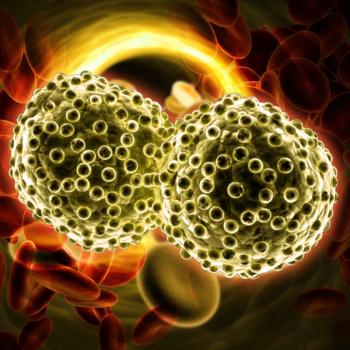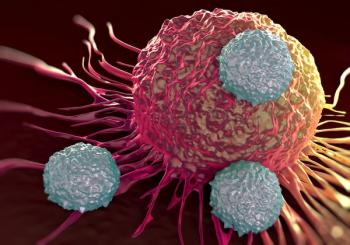
Oncology NEWS International
- Oncology NEWS International Vol 11 No 5
- Volume 11
- Issue 5
Evidence Suggests That Correcting Anemia May Prolong Survival in Cancer Patients
LOS ANGELES-Preclinical and early clinical evidence indicates that correcting anemia might prolong survival in cancer patients, reported John Glaspy, MD, MPH, at the Fifth Quality of Life in Oncology Symposium in Pasadena, California. He called for more prospective randomized trials specifically designed to investigate the effect of anemia on survival.
LOS ANGELESPreclinical and early clinical evidence indicates that correcting anemia might prolong survival in cancer patients, reported John Glaspy, MD, MPH, at the Fifth Quality of Life in Oncology Symposium in Pasadena, California. He called for more prospective randomized trials specifically designed to investigate the effect of anemia on survival.
Dr. Glaspy is medical director of the Boyer Oncology Clinic and professor of medicine at the University of California School of Medicine in Los Angeles. He served as co-chair of the symposium, which was supported by an unrestricted educational grant from Amgen.
"In cancer patients, anemia might contribute to disease progression by decreasing the efficacy of radiation therapy, by impacting the biology of cancer to favor a higher virulence, and by decreasing the functional status of our patients so that they don’t receive optimal treatment," he explained.
A Newer Model
The newer model of the anemia of chronic disease contrasts with the traditional model in two very important waysby proposing a correlation between the degree of anemia and the severity of disease and predicting that specific treatment of anemia might alter the course of disease. "This has obvious implications for the importance of treatment," Dr. Glaspy asserted.
In a study of rats with induced anemia, researchers looked into which cytokines mediate the anemia of chronic disease and found "an exuberant IL-1 and TNF response on the part of inflammatory cells," Dr. Glaspy said. In one arm of the study, anemic rats treated with darbepoetin alfa (Aranesp) had an inflammatory reaction of macrophages that was close to the control group. "This is one piece of a very large body of evidence that the anemia of chronic disease may contribute to the inflammatory milieu that results in a downhill spiral," Dr. Glaspy said.
A literature search would reveal an emerging body of epidemiology evidence that the anemias of chronic diseases are predictive of poor outcomes for those diseases, Dr. Glaspy said. These diseases include inflammatory bowel disease, liver disease, rheumatoid arthritis, systemic lupus erythematosus, HIV, congestive heart failure, and several types of cancer. This suggests that anemia may simply be a marker for the severity of disease or a contributing factor to the outcome.
There is much evidence to show that hypoxia "produces a growth advantage for tumor cells," Dr. Glaspy reported. "It decreases the expression of a tumor suppressor gene, P53. It increases resistance to apoptosis. And it increases chemotherapy resistance and decreases local disease control. Resistance to Adriamycin, VP16, and the vinca alkaloids, has been reported to evolve more rapidly in hypoxic cells. So cancer cells that are raised in hypoxic environments become more resistant to treatment." The relative risk of death as a function of anemia varies with tumor type.
Radiotherapy Studies
Radiation therapy data show that tumors in patients with mild anemia are more hypoxic than tumors in patients with more severe anemia or those who have normal hemoglobin levels. A study with head and neck cancer patients found that patients with hemoglobins under 13 g/dL usually had hypoxic tumors. "Survival was greater in the tumors that weren’t hypoxic," Dr. Glaspy said.
In an interventional study, head and neck cancer patients with hemoglobin levels under 14.5 g/dL were prospectively assigned to receive or not receive erythropoietin. "Those that were not placed on erythropoietin and had started slightly anemic had worse local control and survival," Dr. Glaspy said. "This is getting closer to the mark of asking whether it’s the anemia as a marker or the anemia as a driver of the biology of the disease."
He noted that hematocrit levels over 12 g/dL or even over 13 or 14 g/dL are needed to predict disease-free survival of cervical cancer patients following radiation. "Our idea of normal hemoglobin or optimal hemoglobin for patients is rising as we start to talk about survival," Dr. Glaspy said (see Figure 1).
In another study with cervical cancer patients treated with radiation, the degree of anemia during treatment was "very predictive of survival," Dr. Glaspy said. "The degree of anemia at baseline was not. If anemia were a pure marker for a bad tumor and not contributing in some way to the response to the treatment, you would not expect this pattern in the survival curves." Another study with lung cancer also found that "the degree of anemia that patients develop during radiation if they start nonanemic is predictive of survival."
Chemotherapy Studies
A prospective, randomized, placebo-controlled quality-of-life study of cancer patients receiving chemotherapy for solid tumors and hematologic malignancies found longer survival for those receiving epoetin alfa (Epogen, Procrit).
A study of lung cancer patients receiving cisplatin-based chemotherapy with or without darbepoetin alfa showed superior disease-free survival in the darbepoetin alfa group for patients with small-cell tumor type (see Figure 2, above).
Articles in this issue
over 23 years ago
Prognosis Good for Local Recurrence After Lumpectomyover 23 years ago
Long-Term Use of Actiq Safe and Effective for Breakthrough Painover 23 years ago
Youth Exposed to Tobacco Promotionsover 23 years ago
Green Tea May Help Prevent Certain Gastrointestinal Cancersover 23 years ago
EGFR Inhibitor Effective as Salvage Therapy for NSCLCover 23 years ago
Targeted Filgrastim Support Allows Planned Chemotherapy Dosesover 23 years ago
Low Risk of CHF With Paclitaxel/Trastuzumab Adjuvant Rxover 23 years ago
Anxiety, Depression in Women at High Risk for Breast Cancerover 23 years ago
NCCN Updates its Treatment Guidelines for Breast Cancerover 23 years ago
Danny Glover ‘Acting’ as Spokesman for Anemia LifeLineNewsletter
Stay up to date on recent advances in the multidisciplinary approach to cancer.
































































































